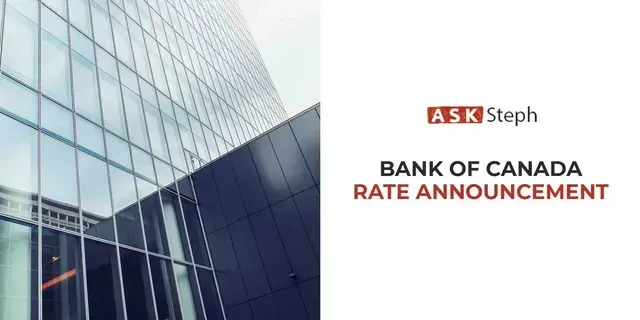What Will Mortgage Financing Look Like In 2021?
Stephanie Barritt • November 4, 2020

There is no doubt that 2020 was one for the books. It will be remembered as a year like no other. COVID-19 has caused significant national economic disruption, to say the least. While we’ve seen government intervention, record unemployment, mortgage payment deferrals, record low-interest rates, we’ve also seen continued growth in the housing market.
So what can we expect as we complete the final quarter in 2020 and move into 2021? Well, low interest rates and increased scrutiny on all mortgage applications are most likely in the cards.
Low interest rates
Right now, both fixed and variable rate mortgage rates are at all-time lows. The cost to borrow money for a mortgage has never been cheaper. According to the Bank of Canada, we can expect them to stay low for the foreseeable future. “Interest rates are very low, and they are going to be there for a long time. Canadians and Canadian businesses are facing an unusual amount of uncertainty, so we have been unusually clear about the future path for interest rates.”
And while low interest rates are a good thing for financing property now, unfortunately, they won’t be as easy to access as in previous years.
More scrutiny on mortgage applications
While we don’t expect lender or insurer guidelines to change much in the coming months, securing mortgage financing in a post-COVID economy has already proven to be harder as lenders apply increased scrutiny to each application. Every mortgage application is being looked at more deeply, and additional documentation is being requested to substantiate your application. Lenders are being more cautious about who they’re lending money to.
If you’re self-employed or rely on overtime, bonuses, or picking up additional shifts to make ends meet, securing a mortgage is going to be more difficult for you. As lenders look at a 2 year average for employment, if you took a hit to your income in 2020, that will impact you in 2021. Any type of non-guaranteed income will be more scrutinized.
If the pandemic impacted your employment and you deferred any payments (credit card, loan, line of credit, or mortgage), expect to be questioned. Lenders will ask for your story; they will want to know why you had to defer payments and how you are now in a better financial position.
Unfortunately, one of the common complaints about getting a mortgage is that it is very document-intensive. Lenders want to see a lot of supporting documents for every mortgage application. And moving into mortgage financing in 2021, you can expect even more requests for supporting documents.
Have a plan in place
So while the housing market continues to grow and low rates make it a good time to buy, the best way to prepare for increased scrutiny and documentation on your mortgage application is to plan ahead.
If your mortgage is up for renewal, you’d like to refinance, or you’re planning on buying a new property, the best thing to do is to get started immediately. Getting together your documents will take time; having a plan on what that looks like is the way to go.
I would love to have a conversation and outline all your options. If you have any questions, please don’t hesitate to contact me anytime!
RECENT POSTS

Bank of Canada maintains policy rate at 2.1/4%. FOR IMMEDIATE RELEASE Media Relations Ottawa, Ontario December 10, 2025 The Bank of Canada today held its target for the overnight rate at 2.25%, with the Bank Rate at 2.5% and the deposit rate at 2.20%. Major economies around the world continue to show resilience to US trade protectionism, but uncertainty is still high. In the United States, economic growth is being supported by strong consumption and a surge in AI investment. The US government shutdown caused volatility in quarterly growth and delayed the release of some key economic data. Tariffs are causing some upward pressure on US inflation. In the euro area, economic growth has been stronger than expected, with the services sector showing particular resilience. In China, soft domestic demand, including more weakness in the housing market, is weighing on growth. Global financial conditions, oil prices, and the Canadian dollar are all roughly unchanged since the Bank’s October Monetary Policy Report (MPR). Canada’s economy grew by a surprisingly strong 2.6% in the third quarter, even as final domestic demand was flat. The increase in GDP largely reflected volatility in trade. The Bank expects final domestic demand will grow in the fourth quarter, but with an anticipated decline in net exports, GDP will likely be weak. Growth is forecast to pick up in 2026, although uncertainty remains high and large swings in trade may continue to cause quarterly volatility. Canada’s labour market is showing some signs of improvement. Employment has shown solid gains in the past three months and the unemployment rate declined to 6.5% in November. Nevertheless, job markets in trade-sensitive sectors remain weak and economy-wide hiring intentions continue to be subdued. CPI inflation slowed to 2.2% in October, as gasoline prices fell and food prices rose more slowly. CPI inflation has been close to the 2% target for more than a year, while measures of core inflation remain in the range of 2½% to 3%. The Bank assesses that underlying inflation is still around 2½%. In the near term, CPI inflation is likely to be higher due to the effects of last year’s GST/HST holiday on the prices of some goods and services. Looking through this choppiness, the Bank expects ongoing economic slack to roughly offset cost pressures associated with the reconfiguration of trade, keeping CPI inflation close to the 2% target. If inflation and economic activity evolve broadly in line with the October projection, Governing Council sees the current policy rate at about the right level to keep inflation close to 2% while helping the economy through this period of structural adjustment. Uncertainty remains elevated. If the outlook changes, we are prepared to respond. The Bank is focused on ensuring that Canadians continue to have confidence in price stability through this period of global upheaval. Information note The next scheduled date for announcing the overnight rate target is January 28, 2026. The Bank’s next MPR will be released at the same time.

Wondering If Now’s the Right Time to Buy a Home? Start With These Questions Instead. Whether you're looking to buy your first home, move into something bigger, downsize, or find that perfect place to retire, it’s normal to feel unsure—especially with all the noise in the news about the economy and the housing market. The truth is, even in the most stable times, predicting the “perfect” time to buy a home is incredibly hard. The market will always have its ups and downs, and the headlines will never give you the full story. So instead of trying to time the market, here’s a different approach: Focus on your personal readiness—because that’s what truly matters. Here are some key questions to reflect on that can help bring clarity: Would owning a home right now put me in a stronger financial position in the long run? Can I comfortably afford a mortgage while maintaining the lifestyle I want? Is my job or income stable enough to support a new home? Do I have enough saved for a down payment, closing costs, and a little buffer? How long do I plan to stay in the property? If I had to sell earlier than planned, would I be financially okay? Will buying a home now support my long-term goals? Am I ready because I want to buy, or because I feel pressure to act quickly? Am I hesitating because of market fears, or do I have legitimate concerns? These are personal questions, not market ones—and that’s the point. The economy might change tomorrow, but your answers today can guide you toward a decision that actually fits your life. Here’s How I Can Help Buying a home doesn’t have to be stressful when you have a plan and someone to guide you through it. If you want to explore your options, talk through your goals, or just get a better sense of what’s possible, I’m here to help. The best place to start? A mortgage pre-approval . It’s free, it doesn’t lock you into anything, and it gives you a clear picture of what you can afford—so you can move forward with confidence, whether that means buying now or waiting. You don’t have to figure this out alone. If you’re curious, let’s talk. Together, we can map out a homebuying plan that works for you.



